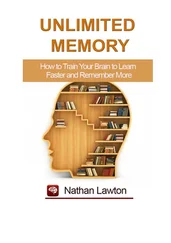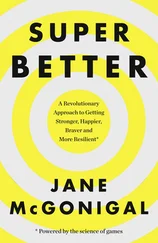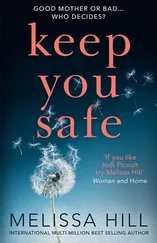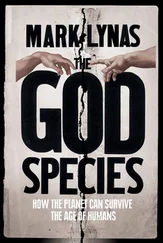Roopnarine’s simulations are infinitely more complex than Wator, incorporating the smallest planktons to the largest predators, and everything in between. In them, he describes relationships between predators and prey that lived millions of years ago. And from these models, he’s generated a theory about why the Triassic burned through so many food webs.
He began by coming up with a way to generate a realistic food web for species that no longer exist. He included every known form of life from the fossil record, and then he extrapolated predator–prey relationships based on what we know about how animals behave today. “You can’t ever know exactly what a fossil animal was eating—you can’t even know that with animals today,” Roopnarine explained. “But we can use the body size, tooth shapes, and other things to decide who their prey might have been.” Predators’ body sizes are helpful because, obviously, a small predator will prefer small prey, while a larger predator might be a generalist who can eat creatures of many sizes.
There are always complications, Roopnarine admitted. Many species share the same potential prey or predators, and it’s hard to know which species might have been generalists with many food sources, or specialists with just a few. But the beauty of using computers to simulate food webs is that you can go through as many iterations as you like, creating different worlds each time paleontologists discover more about a fossil predator’s range or appetites. Plus, there are a few rules of thumb, including the fact that there are usually far more specialists than generalists. Once the ancient food web has been set up in his program, Roopnarine said, he can simulate food-web disturbances like the one in the early Triassic.
Based on what he’s figured out so far, Roopnarine’s theory is that a basic imbalance in early Triassic food webs led to millions of years of maimed ecosystems rising and collapsing in rapid succession. Initially, the problem was that so few creatures had survived the Permian mass extinction. Of the survivors, he said, “you have small carnivores and some seriously big, bad amphibians who are the precursors of crocodiles.” Among herbivores, he said, lystrosaurs were the only game in town. The problem was that nobody around seemed to be eating Lystrosaurus , perhaps because they were the wrong size or in the wrong environments for most predators. In fact, the food web began to unravel because there were so many carnivores and very few prey.
Those “big, bad amphibians,” known as crurotarsans, were in fierce competition with each other. With their huge, toothy mouths and muscular tails, they would have been deadly predators—and Roopnarine says that the competition between carnivores during the early Triassic was more intense than in any other food web he’s looked at. The carnivores competed with each other so intensely for the tiny amount of available prey that they wound up driving each other to extinction over and over. New creatures would evolve, then get crushed out of existence. Only the herbivore Lystrosaurus , and eventually other herbivores, really recouped their losses. It took tens of millions of years before there were a small enough number of carnivores for food webs to stabilize.
This raises the question of what makes for a stable food web over the long term. And there’s an easy answer. “Diversity,” Roopnarine said firmly. A food web needs to be “robust,” full of many kinds of carnivores, herbivores, and plants, in order to withstand an environment that can often hammer creatures with everything from volcanoes to drought and sea-level shifts. As long as there are many nodes in a food web, a healthy balance of predator and prey, you have a community of life-forms that can remain steady even when the environment wobbles.
“So does that suggest some communities are better than others when it comes to survival?” I asked.
Roopnarine offered a conspiratorial nod. “This can be controversial, but yes, you could say this is natural selection at the community level.” Food webs don’t compete the same way two species might because they don’t exist next to each other, trying to eat the same things and live in the same caves. Instead, they compete with each other temporally, replacing each other in the same geographical places over time. To “win” the natural-selection game, a food web must outlast other food webs, remaining stable for as long as possible in the same place. Looked at from this perspective, you might consider all of Earth’s geologic history a competition between food webs struggling to last through as many environmental disasters as possible, simply by retaining their robustness in the face of calamity.
Survival is never just a matter of one species being exceptionally adept. We only survive in the context of our food webs. And when a food web starts to unravel, the extinction of one creature will mean the “secondary extinctions” of others.
Roopnarine and his colleagues have run enough simulations of food-web collapse that they’ve discovered a pattern. You can take away up to 40 percent of the life-forms in a system, and the number of secondary extinctions doesn’t increase significantly. “But there’s a critical interval after that where things happen rapidly—a threshold effect,” Roopnarine said. “The secondary extinction numbers rise dramatically.”
Imagine a world like the one we live in today, with a variety of creatures in many different environments. Let’s say we begin to chip away at one of those environments, like the American prairies. People clear grasslands, kill both predator and prey animals, and destroy insect pests. Still, the food web seems stable. Creatures and plants go extinct in the region, but there seems to be no ripple effect. And then, after centuries, we hit a tipping point. Forty percent of the nodes in the prairie food web have been knocked out. Suddenly, there are predators with very few prey. Catastrophic deaths among predators result: They are competing for scarce or no resources. And then a drought hits, killing the few remaining prairie grasses. Now our tiny herbivore population goes mostly extinct. We are left with few predators and virtually no prey. The already unstable food web falls apart, one death leading to another—and making the community more vulnerable to climate fluctuations.
“Don’t expect the unraveling to be linear,” Roopnarine warned. The deaths will be exponential. Once we hit the threshold, our food web has lost in the war of community selection. A new food web will rise up to take its place, turning the American prairie into a whole new world full of strange predators and grasses unlike any we’ve ever seen.
So the Permian extinction event yields a double lesson in survival. First, it offers compelling evidence that climate change caused by greenhouse gases can kill nearly every creature on the planet. Regardless of how that greenhouse scenario starts—whether it’s a massive volcano or an industrial revolution—climate change can kill more effectively than a meteorite impact. Of course, atmospheric changes were only the first phase in a problem that lasted 30 million years. One could argue that food-web collapse is really what makes the Permian mass extinction a “Great Dying.” The scourge started by Permian megavolcanoes echoed for millions of years, rending food web after food web until at last equilibrium was achieved in the Triassic period.
Still, there were survivors. Humans and many other mammals on Earth owe our existence to a bunch of piglike creatures with beaks who loved the sunny southern climate. That Lystrosaurus survived for millions of years (much longer than Homo sapiens has been around) proves that complex life can make it through even the most terrible disasters. These lumbering proto-mammals also left behind a few tips for what to do when we hit that wall of toxic air. By following in the lystrosaurs’ footsteps, mammals dodged the next major mass extinction—even though many dinosaurs didn’t.
Читать дальше
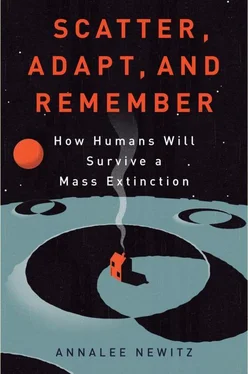





![Аннали Ньюиц - Автономность [litres]](/books/424681/annali-nyuic-avtonomnost-litres-thumb.webp)

